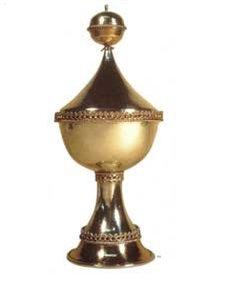British Museum to acquire £1.3m Lacock cup from church
- Published
The money will be used to pay for repairs to the church
A Wiltshire church has been told it can sell an "extremely rare" £1.3m silver medieval chalice to the British Museum.
The Lacock Cup, which dates back to the 1400s, was loaned to the museum from St Cyriac's Church in Lacock in 1962.
The church now wants to sell the cup to raise funds for repairs, but this had been opposed by a local resident so a church court was set up to decide.
At the consistory court the Reverend Justin Gau said he was satisfied the sale circumstances were justified.
'Urgent work'
Geoffrey Fox, who objected to the sale, now has 28 days to consider whether or not he wants to appeal the decision.
He said he was "very disappointed" by the ruling.

The British Museum said the cup was in "near perfect condition"
A group of residents had campaigned against the sale believing the cup was a vital part of the village's heritage.
Church warden Tony Bruun said because St Cyriac's was a medieval church the maintenance needed was considerable.
He said the church had spent more than £400,000 over the past 10 years on repairs and maintenance and that figure did not include any restoration work.
"Every five years an architect makes recommendations for urgent work, work which can be done over the five years and restorative work," he added.
"[For example] this lady chapel has polychrome decoration and high-vaulted ceilings. All of this would be lovely to restore but that will cost a lot of money - about £60,000 which we don't have."
'Extremely rare'
In a statement, the British Museum said it would now launch a fundraising campaign to "acquire this important object for the nation".
"The Lacock cup is an extremely rare piece of medieval English silverware, with a history dating to the first half of the 15th Century," the museum continued.
"The cup, which is in near perfect condition, began its life as a secular object but its function changed after the English Reformation as new religious practices meant that a larger communion cup was required to hold sufficient wine for the whole congregation.
"As the cup has no religious imagery on it, it was a perfect substitute in a time when strict laws prohibited the use of images."